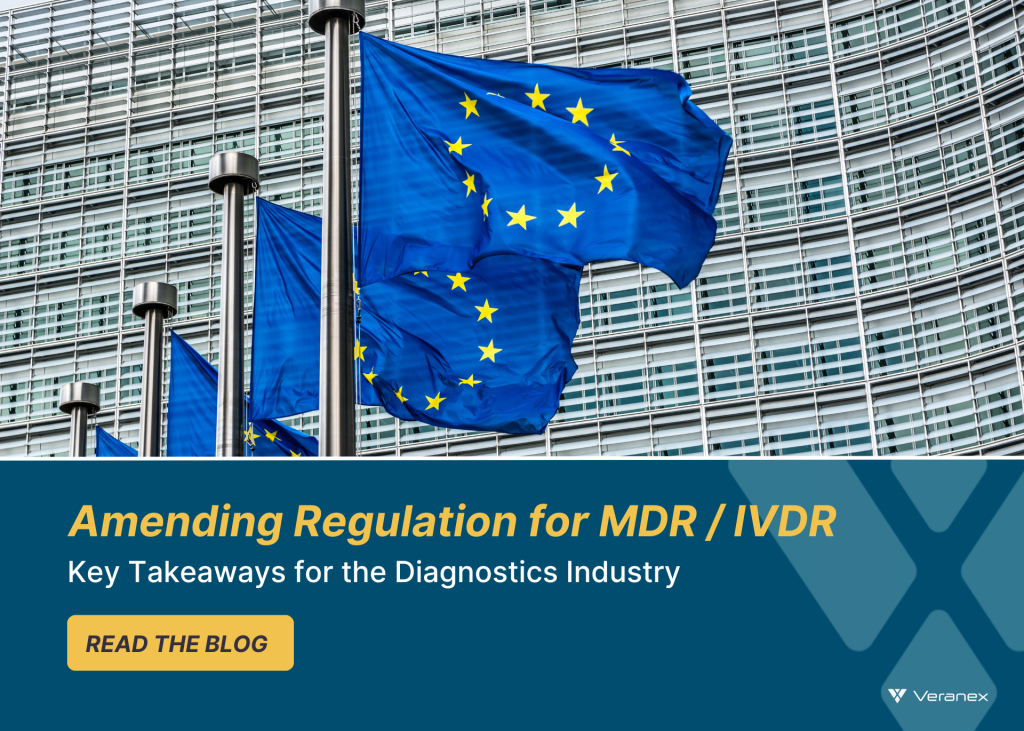3 min read
Amending Regulation for MDR / IVDR: Key Takeaways for the Diagnostics Industry
Veranex : Apr 26, 2024 9:41:14 AM

The EU Parliament adopted the regulation amending EU 2017/745 (MDR) and EU 2017/746 (IVDR) aiming to protect patients by ensuring the availability of safe devices that are essential for healthcare systems. The amending regulation extends the transition periods for certain IVDs (legacy devices and in-house devices) subject to the fulfillment of certain conditions and introduces a gradual rollout of EUDAMED and a new obligation for manufacturers to give a prior notice in case of disruption of supply.
Here’s a quick overview of the changes put forward by the amending regulation.
Ensuring availability of IVDs
The availability of safe and effective IVDs is essential for patient care and the regulation EU 2017/746 aims to modernize the EU framework to ensure safe and effective devices are made available to the EU public.
80% of the IVDs under IVDD are self-certified (i.e., no involvement of a notified body in the conformity assessment process) and under the new regulation, shall need a notified body intervention for obtaining a CE mark. One of the big challenges for the IVD industry in the process of complying with the new requirements is the availability of notified bodies that can support in conformity assessment process. To ensure the availability of such devices, the amending regulation proposes more time for manufacturers to comply with new requirements under certain conditions, without compromising safety requirements.
Devices for which the conformity assessment procedure under Directive 98/79/EC did not require the involvement of a notified body (up-classified devices) will benefit from longer transition periods provided certain conditions are met. The proposed transition periods are:
- Class D — 31 December 2027 (instead of the current May 26, 2025)
- Class C — 31 December 2028 (instead of the current May 26, 2026)
- Class B and A sterile — 31 December 2029 (instead of the current May 26, 2027)
Only ‘legacy devices’ (as defined in MDCG 2022-8) may benefit from extended transition periods if they fulfil the following conditions:
- Devices continue to comply with 98/79/EC (IVDD)
- No significant changes in the design and intended purpose
- The devices do not present an unacceptable risk to the health or safety of patients, users or other persons, or to other aspects of the protection of public health: “unacceptable risk to health and safety”
- No later than 26 May 2025, the manufacturer has put in place a quality management system (QMS)
- By a specific date (26 May 2025 — class D, 26 May 2026 — class C or 26 May 2027 — classes B and A sterile), the manufacturer, or authorized representative, has lodged a formal application for conformity and within four months, such an application must be covered by a written agreement between the notified body and the manufacturer.
It’s important to note that manufacturers of legacy devices can benefit from longer transition periods only when the above-mentioned conditions are met, and these conditions would have a direct impact on the transitional effort.
- As one of the requirements is the implementation of a QMS in agreement with IVDR by May 26, 2025, the certification of the QMS could become one conditional requirement to having in place a written agreement with a Notified Body. As the average time needed for issuing a QMS certificate is usually between 6–12 months, it is recommended that manufacturers continue with the transition efforts without a pause.
- Secondly, the assessment of unacceptable risks to health and safety could also imply that manufacturers would need to implement during the transition period a thorough evaluation of the risk: benefit acceptability of their device when compared to the state of the art. The translation of such requirement shall be the implementation of Risk Management, Post Market Surveillance, and the assessment of the Performance Evaluation that would allow for a conclusion on the clinical benefit (safety and performance) of a device when compared to the state-of-the-art in the field.
- Moreover, the incompleteness of the applications of conformity assessment remains an acute problem (25–50% of applications are complete) which consequently will impact the timelines for the conformity assessment process. It is important to note that the time needed for issuing QMS and product certificates according to IVDR ranges between 13–24 months depending on the risk class, quality of documentation submitted, etc.
Obligation of interruption of supply
Manufacturers are now required to give prior notice (ideally 6 months in advance) if they foresee an interruption of supply of IVDs or medical devices.
Gradual roll-out of EUDAMED
As a measure to enhance transparency regarding medical devices made available on the EU market, the amending regulation shall enable the gradual implementation of the individual EUDAMED modules that are audited and declared functional. As such mandatory use of several EUDAMED modules start as early as Q4 2025.
Although extending transition periods based on device risk classes supports a better implementation of the regulation and gives adequate time for the industry to prepare for the transition, we strongly encourage IVD manufacturers to continue their transitional efforts without any pause!



